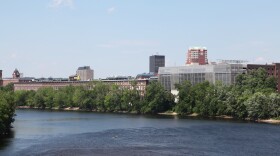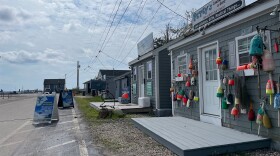Summer is finally here, fish are jumping, and fishing guides are busy.
NHPR's Sean Hurley went out with a couple of guides just before their busy season began and learned some of their secrets.
There’s a time in late spring before the smelt begin to run and the salmon leave the lakes to chase them down river that a certain kind of fisherman - like Bill Bernhardt and Paul Starring - will go and stand in rushing cold waters to cast their lines and lace their nymphs over the rocky bottoms.
“We never catch anything early season,” Bernhardt says, laughing.
"Yeah, we never catch anything,” Starring agrees.
“Because the fishing is just not generally there, you know?” Bernhardt explains.
When I tell Bernhardt that it might be hard to do a story about fishing if we don’t catch any fish, he gives me an angle to work. “So our marketing on that is going to be fish like a guide,” he says. “Because your good guides don't get a chance to fish when the fishing's good. Your good guides get a chance to fish when the fishing is bad before the season and when the fishing is bad after the season. So you want to learn how to fish, fish like a guide.”
So off we go in rubber waders to stand in the frigid waters of the Connecticut River in the northernmost part of the state…to fish like guides.

“This is the top of the Trophy Stretch where we're at right now,” Bernhardt says. “So you have roughly 2.3 miles of this section of river that runs down to Lake Francis. I took a water temperature. So the water temperature is 38 degrees roughly. So that's really, really cold. When it gets that cold the fish just aren't as active, the bugs aren't as active, so the fish are gonna sit down there and they're still gonna be fish but their metabolism is going to be a lot slower so they're just not going have to feed as often et cetera et cetera. It's going to make you work harder for it.”
Water temperatures in the low to mid 50’s would be ideal, Bernhardt says, but such warmth is still a few weeks away.
Bernhardt examines his flies – begins to remove the barbs from each hook. “What we do is just catch and release,” he explains, “so it's just easier to take the fish off the hook if it doesn't have that little barb on it.”

Paul Starring fishes in knee deep water, flicking his line upriver and watching the orange bobber, or indicator as he calls it, float back down on the hard moving current. “Sometimes you'll watch that little indicator and it'll bump bump bump – OK?” he says. “So sometimes it’s a rock. You know you hear a lot of people, ‘oh it was just a rock’. You know it could have been a fish doing a really quick little little nip on it.”
After 30 minutes without a nip, Bernhardt suggests we hike through the woods and try a different spot

further down. “This spot in particular is what they call Judges and Juries,” he says and points out two descending watery plateaus, the upper spilling over rocks into the lower. “So this is the judge's box there and that's the jury box down there. A long time ago a judge used to fish here and that's why they named it that way.”
As Starring begins to cast, Bernhardt finds a knoll above the river. “A lot of times, if the light’s right you can see fish in here,” he says, staring down into a patch of calmer water.
“So you watch the water long enough and eventually a clear pane will go across - a window - and you'll be able to kind of look right down there and see. I haven't seen anything yet.”

Bernhart strides into the current and presses his face to the water. He plies a black stone from the river bottom and spins it over.
“Really small mayfly nymph right there. Right off my fingertip?” he says and nudges a tiny worm-like insect. “So see there's some caddis larva? So a lot of times people will talk about you know ‘matching the hatch’ so to speak? So you flip over some rocks and you'll be like ‘oh there's a bunch of stone flies here’ or there's a bunch of mayflies and caddis's. And so now you know it's like - if I was a trout, what am I going to be feeding on, you know? Mayflies and caddises and stone flies.

“Matching the hatch” then is fishing with flies or nymphs of the bugs you find active in the water.
After fishing for nearly two hours in the high fishless tradition of the best sorts of guides, Bernhardt and Starring agree – we should call it a day.
But there’s no such thing as a bad day fishing, Starring says. “You know first of all look where you are,” he says. “You know you're out in a beautiful location, I mean this is pretty gorgeous. You know I don't need to be catching fish every five seconds.”

But as we drive away from the river, Bernhardt says, in just a few short days both he and Starring will be leading small groups of anglers who hope to do just that. “Right now I only have one full day off in the month of June,” he reports, “so pretty much after I think next Wednesday I'll be right out for a while.”
And what’s a fishing guide do on his one day off in thirty? “Chances are if I had a free day off I'm going fishing anyways!” Bernhardt says and laughs.
Bill Bernhardt won’t be fishing like a guide on that lone day in June and he spreads his hands wide to show me the massive size of the future fish he’s bound to catch.








